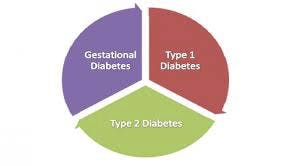
There are three main types of diabetes—type 1, type 2 and gestational—and each can affect your body in different ways and may require different treatments. Here’s some basic information about each one.
Type 1
Type 1 diabetes, sometimes called insulin-dependent diabetes and previously known as juvenile diabetes, is a condition in which the pancreas doesn’t produce enough—or any—insulin. Insulin is a hormone that your body needs to let sugar (glucose) into your cells to produce energy.
Type 2
Type 2 diabetes is the most common form of diabetes. In this type, your body doesn’t make enough insulin or doesn’t use it properly. Initially, your pancreas may make extra insulin, but over time it can’t make enough to keep up. Without insulin to bring glucose to your cells for energy, too much glucose can build up in the blood, which can starve your cells of energy and result in a number of problems over time. Symptoms are similar to type 1 diabetes, though sometimes milder.
Gestational
Gestational diabetes only occurs during pregnancy. If you have never had diabetes before but have high blood glucose levels during pregnancy, you are said to have gestational diabetes. Medical experts believe the hormones from the placenta may make the mother’s insulin less effective. If it’s left untreated, it could result in problems for the baby, like a higher risk for breathing problems and obesity and type 2 diabetes later in life.
Picture Credit : Google

